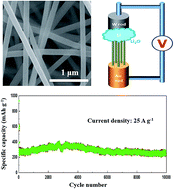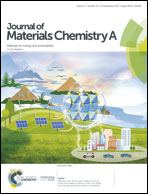Synthesis of three-dimensional free-standing WSe2/C hybrid nanofibers as anodes for high-capacity lithium/sodium ion batteries†
Abstract
In recent years, although there has been great progress in the exploration of high capacity alkali metal ion batteries, the design of high-durable anode materials with high power density remains challenging. In this study, a flexible three-dimensional network of WSe2/C is reported as a dual-role anode for lithium/sodium ion batteries, providing multichannels for the fast lithium/sodium ion diffusion and a buffer matrix to restrain the volume change as well as increase the electron conductivity. The in situ transmission electron microscopy characterizations reveal a minor volume expansion of the WSe2/C (∼8.2%) and a complete-amorphization event occurring after the first lithiation process. WSe2/C exhibited superior reversible capacity/rate capability/cycling stability in lithium/sodium ion batteries. Particularly, a large stable capacity and ultra-long cycling life at ultra-high rate (257.0 mA h g−1 at 25 A g−1 after 10 000 cycles) are achieved for the WSe2/C electrode in lithium ion batteries, accompanied by only 0.5% capacity loss per cycle over 1000 cycles, which reveals its excellent capacity stability at ultra-high rates. This study reveals the great potential of WSe2/C as a high-capacity dual-role anode for lithium/sodium ions batteries.



 Please wait while we load your content...
Please wait while we load your content...